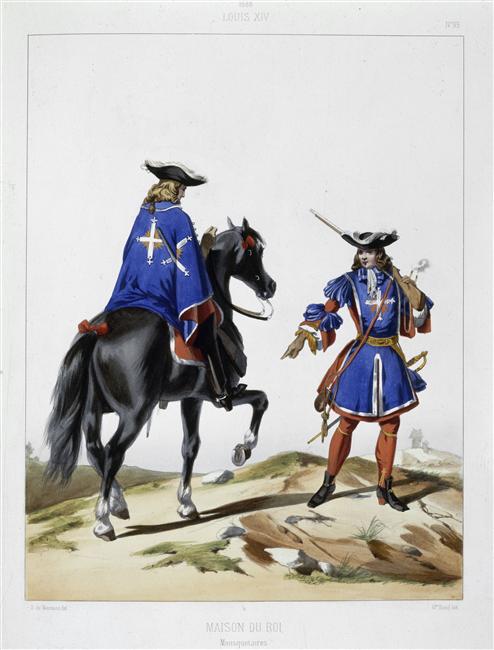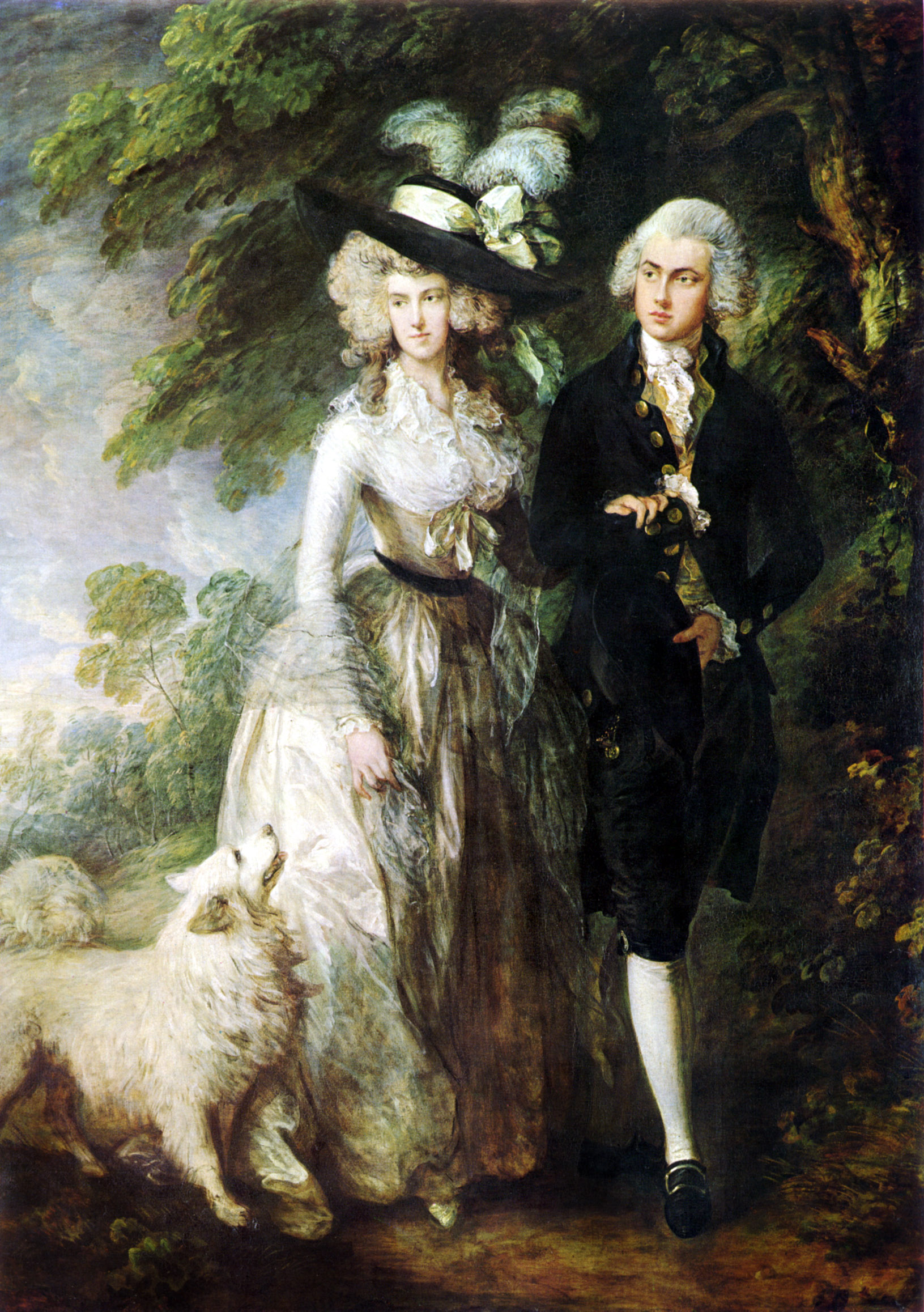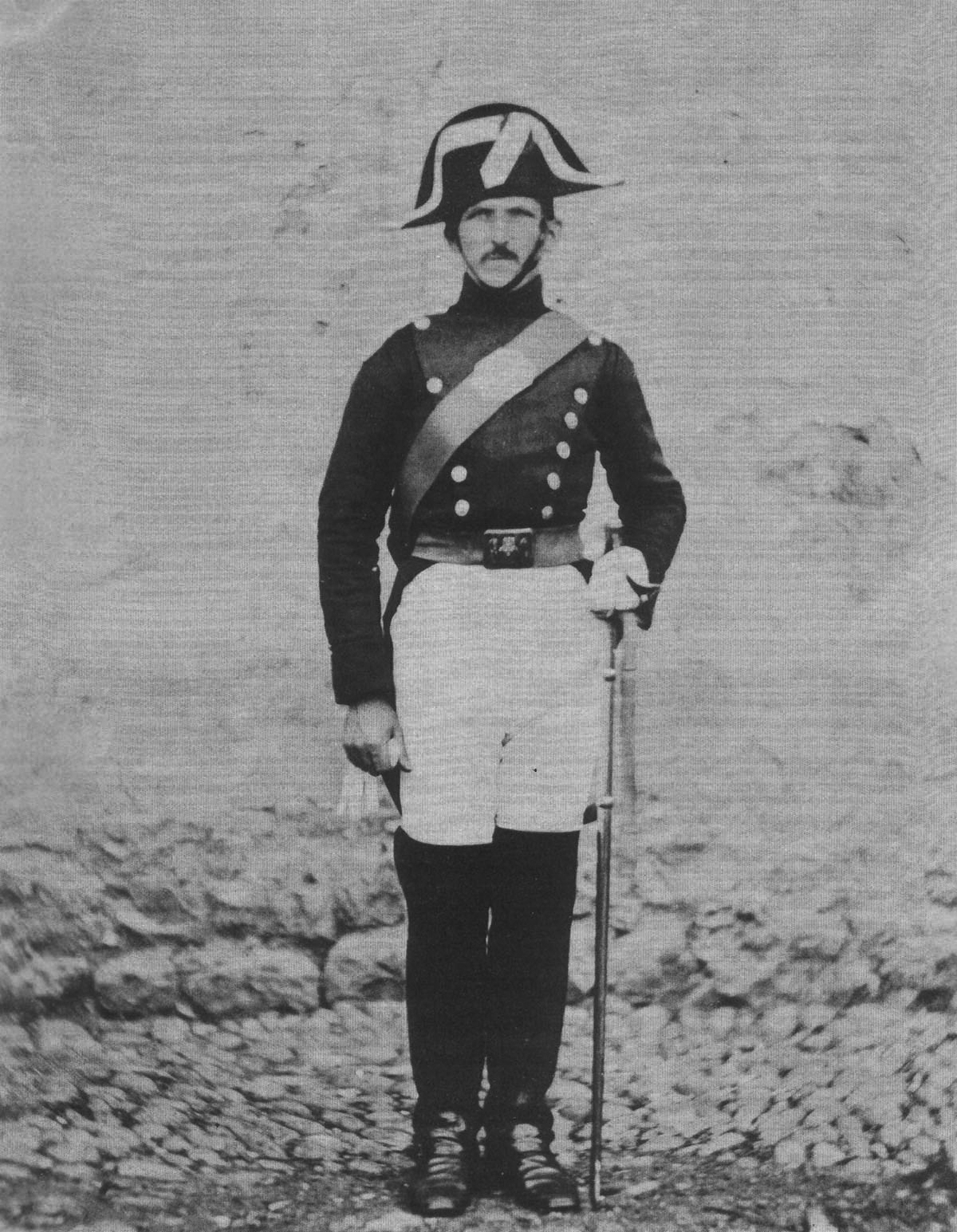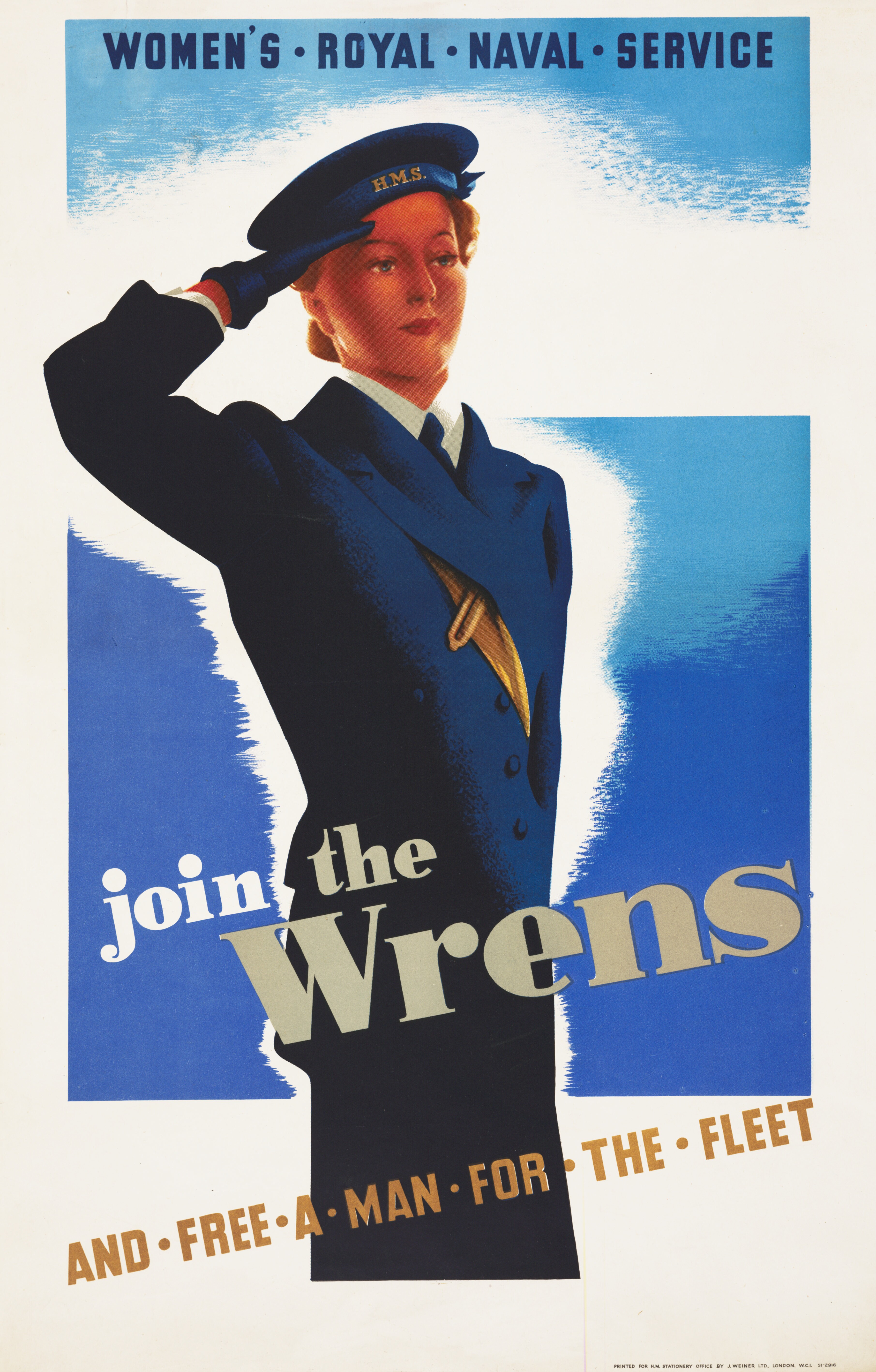|
Tricorne
The tricorne or tricorn is a style of hat in a triangular shape, which became popular in Europe during the 18th century, falling out of style by the early 1800s. The word "tricorne" was not widely used until the mid-19th century. During the 18th century, hats of this general style were referred to as "cocked hats". At the peak of its popularity, the tricorne varied greatly in style and size, and was worn not only by the aristocracy, but also as common civilian dress, and as part of military and naval uniforms. Typically made from animal fiber, the more expensive being of beaver-hair felt and the less expensive of wool felt, the hat's most distinguishing characteristic was that three sides of the brim were turned up (cocked) and either pinned, laced, or buttoned in place to form a triangle around the crown. The style served two purposes: first, it allowed stylish gentlemen to show off the most current fashions of their wigs, and thus their social status; and secondly, the cocked ... [...More Info...] [...Related Items...] OR: [Wikipedia] [Google] [Baidu] |
1775–1795 In Western Fashion
Fashion in the twenty years between 1775 and 1795 in Western culture became simpler and less elaborate. These changes were a result of emerging modern ideals of selfhood, the declining fashionability of highly elaborate Rococo styles, and the widespread embrace of the rationalistic or "classical" ideals of Age of Enlightenment, Enlightenment philosophes. Enlightenment concept of "fashion" According to some historians, it was at this time when the concept of fashion, as it is known today, was established (others date it much earlier). Prior to this point, clothes as a means of self-expression were limited. Guild-controlled systems of production and distribution and the sumptuary laws made clothing both expensive and difficult to acquire for the majority of people. However, by 1750 the consumer revolution brought about cheaper copies of fashionable styles, allowing members of all classes to partake in fashionable dress. Thus, fashion begins to represent an expression of individualit ... [...More Info...] [...Related Items...] OR: [Wikipedia] [Google] [Baidu] |
Bicorne
The bicorne or bicorn (two-cornered) is a historical form of hat widely adopted in the 1790s as an item of uniform by European and American army and naval officers. Most generals and staff officers of the Napoleonic period wore bicornes, which survived as widely-worn full-dress headdress until the 20th century. Historic use Descended from the tricorne, the black-coloured bicorne originally had a rather broad brim, with the front and the rear halves turned up and pinned together forming a semi-circular fan shape; there was usually a cockade in the national colours at the front. Later, the hat became more triangular in shape, with its two ends becoming more pointed, and it was worn with the cockade at the right side. That kind of bicorne eventually became known in English as the ''cocked hat'', but it is still known in French as the ''bicorne''. Worn in the side-to-side athwart style during the 1790s, the bicorne became normally seen fore-and-aft in most armies and navies ... [...More Info...] [...Related Items...] OR: [Wikipedia] [Google] [Baidu] |
Guardia Civil
The Civil Guard (; ) is one of the two national law enforcement agencies of Spain. As a national gendarmerie, it is military in nature and is responsible for civil policing under the authority of both the Ministry of the Interior and the Ministry of Defence. The role of the Ministry of Defence is limited except in times of war when the Ministry has exclusive authority. The corps is colloquially known as the ' (the meritorious or the reputables). In annual surveys, it generally ranks as the national institution most valued by Spaniards, closely followed by other law enforcement agencies and the armed forces. It has both a regular national role and undertakes specific foreign peacekeeping missions and is part of the European Gendarmerie Force. As a national gendarmerie force, the Civil Guard was modelled on the French National Gendarmerie and has many similarities. As part of its daily duties, the Civil Guard patrols and investigates crimes in rural areas, including highways and ... [...More Info...] [...Related Items...] OR: [Wikipedia] [Google] [Baidu] |
James Monroe
James Monroe ( ; April 28, 1758July 4, 1831) was an American Founding Father of the United States, Founding Father who served as the fifth president of the United States from 1817 to 1825. He was the last Founding Father to serve as president as well as the last president of the Virginia dynasty. He was a member of the Democratic-Republican Party, and Presidency of James Monroe, his presidency coincided with the Era of Good Feelings, concluding the First Party System era of American politics. He issued the Monroe Doctrine, a policy of limiting European colonialism in the Americas. Monroe previously served as Governor of Virginia, a member of the United States Senate, U.S. ambassador to France and Britain, the seventh secretary of state, and the eighth secretary of war. During the American Revolutionary War, he served in the Continental Army. Monroe studied law under Thomas Jefferson from 1780 to 1783 and subsequently served as a List of delegates to the Continental Congress, ... [...More Info...] [...Related Items...] OR: [Wikipedia] [Google] [Baidu] |
Chelsea Pensioner
A Chelsea Pensioner, or In-Pensioner, is a resident at the Royal Hospital Chelsea, an Old soldiers' home, Old Soldiers' retirement home and nursing home for former members of the British Army located in Chelsea, London. The Royal Hospital Chelsea is home to 300 retired British soldiers, male and female (the latter since 2009), and is located on Royal Hospital Road. Historically, the term "Chelsea Pensioner" applied more widely, referring to both In-Pensioners and Out-Pensioners who live elsewhere. In- and Out-Pensioners The Royal Hospital was founded by Charles II of England, King Charles II in 1682 as a retreat for veterans.Guidebook, p. 3 The provision of a hostel rather than the payment of pensions was inspired by Les Invalides in Paris. During the reign of King William III and Mary II of England, Queen Mary II, the Royal Hospital was still under construction so they introduced a system for distribution of army pensions in 1689. The pension was to be made available to all form ... [...More Info...] [...Related Items...] OR: [Wikipedia] [Google] [Baidu] |
Top Hat
A top hat (also called a high hat, or, informally, a topper) is a tall, flat-crowned hat traditionally associated with formal wear in Western dress codes, meaning white tie, morning dress, or frock coat. Traditionally made of black silk or sometimes grey, the top hat emerged in Western fashion by the end of the 18th century. Although such hats fell out of fashion through the 20th century, being almost entirely phased out by the time of the counterculture of the 1960s, it remains a formal fashion accessory. A collapsible variant of a top hat, developed in the 19th century, is known as an opera hat. Perhaps inspired by the early modern era capotain, higher-crowned dark felt hats with wide brims emerged as a country leisurewear fashion along with the Age of Revolution around the 1770s. Around the 1780s, the justaucorps was replaced by the previously casual frocks and dress coats. With the introduction of the top hat in the early 1790s, the tricorne and bicorne hats b ... [...More Info...] [...Related Items...] OR: [Wikipedia] [Google] [Baidu] |
Cockade
A cockade is a knot of ribbons, or other circular- or oval-shaped symbol of distinctive colours which is usually worn on a hat or cap. The word cockade derives from the French ''cocarde'', from Old French ''coquarde'', feminine of ''coquard'' (vain, arrogant), from ''coc'' (cock), of imitative origin. The earliest documented use was in 1709. The first cockades were introduced in Europe in the 15th century. The armies of the European states used them to signal the nationality of their soldiers to distinguish allies from enemies. These first cockades were inspired by the distinctive coloured bands and ribbons that were used in the Late Middle Ages by knights, both in war and in tournaments, which had the same purpose, namely to distinguish the opponent from the fellow soldier. The cockade later became a revolutionary symbol par excellence during the insurrectional uprisings of the 18th and 19th centuries. Its main characteristic was that of being able to be clearly visible, thus ... [...More Info...] [...Related Items...] OR: [Wikipedia] [Google] [Baidu] |
List Of Nicknames Of Presidents Of The United States
Presidents of the United States have often acquired nicknames, both flattering and unflattering. This list is intended to note those nicknames that were in common use at the time they were in office or shortly thereafter. George Washington * The American Cincinnatus, like the famous Roman Lucius Quinctius Cincinnatus, he won a war, then became a private citizen instead of seeking power or riches as a reward. He became the first president general of the Society of the Cincinnati, formed by Revolutionary War officers who also "declined offers of power and position to return to his home and plough". * The American Fabius, for his Fabian military strategy during the Revolutionary War * The Father of His Country * His Excellency * Sage of Mount Vernon John Adams * Bonny Johnny, "Bonny" meaning a sizeable person. * The Colossus of Independence, for his leadership in Congress in 1776 * The Duke of Braintree, due to residing in Braintree, Massachusetts and his strong opinions on the ... [...More Info...] [...Related Items...] OR: [Wikipedia] [Google] [Baidu] |
Women's Royal Naval Service
The Women's Royal Naval Service (WRNS; popularly and officially known as the Wrens) was the women's branch of the United Kingdom's Royal Navy. First formed in 1917 for the World War I, First World War, it was disbanded in 1919, then revived in 1939 at the beginning of the World War II, Second World War, remaining active until integrated into the Royal Navy in 1993. WRNS included Cooking, cooks, clerks, Morse code, wireless telegraphists, Plot (radar), radar plotters, weapons analysts, Rangefinding telemeter, range assessors, electricians, air mechanics, ground transport vehicle drivers and despatch_rider, motorcycle dispatch riders. History First World War The WRNS was formed in 1917 during the World War I, First World War. On 10 October 1918, nineteen-year-old Josephine Carr from Cork (city), Cork became the first Wren to die on active service, when her ship, the RMS Leinster, RMS ''Leinster'' was torpedoed. By the end of the war the service had 5,500 members, 500 of them offi ... [...More Info...] [...Related Items...] OR: [Wikipedia] [Google] [Baidu] |
Town Crier
A town crier, also called a bellman, is an officer of a royal court or public authority who makes public pronouncements as required. Duties and functions The town crier was used to make public announcements in the streets. Criers often dressed elaborately, by a tradition dating to the 18th century, in a red and gold coat, white breeches, black boots and a tricorne hat. In English-speaking countries, they carried a handbell to attract people's attention, as they shouted the words "Oyez, Oyez, Oyez!" before making their announcements. The word "Oyez" means "hear ye," which is a call for silence and attention. ''Oyez'' derives from the Anglo-Norman word for ''listen'' (modern French, ''oyez'', infinitive, ''ouïr'', but has been largely replaced by the verb ''écouter''). The proclamations book in Chester from the early 19th century records this as "O Yes, O Yes!". History Europe Prior to widespread literacy, town criers were the means of communication with the people of ... [...More Info...] [...Related Items...] OR: [Wikipedia] [Google] [Baidu] |
Cavalier Hat
A cavalier hat is a variety of wide-brimmed hat which was popular in 17th-century Europe. These hats were often made from felt, and usually trimmed with an ostrich plume. They were frequently cocked up or had one side of the brim pinned to the side of the crown of the hat (similar to the slouch hat) which was then decorated with feathers. Cavalier hats derived their name from supporters of Charles I of England during the English Civil War, known as Cavaliers, who were noted for wearing extravagant clothing. It was a common hat style throughout Europe during the 17th century, until it was later replaced in fashion by the tricorne, which was originally a cavalier hat with its brim bound into a triangle.Castells, Albert. "Los tercios viejos y la presencia española en Flandes", Espasa, Madrid, 1997 See also * List of hat styles * List of headgear Headgear is worn for many purposes, including protection against the elements, decoration, or for religious or cultural reasons, includi ... [...More Info...] [...Related Items...] OR: [Wikipedia] [Google] [Baidu] |
Hat Brim
A hat brim is that part of a hat that extends outwards and to the side of the head, protruding from the base of the crown.''Glossary of Hat Terms'' at tenthstreethats.com. Retrieved 29 March 2023. Hat brims run around the whole of the crown and come in varying widths. It is also called a bill. The outer edge of the brim may have trim made of leather, silk or ribbon material and is known as the brim binding. The brim protects the eyes from both sun glare and . The broader the brim, the greater its protection function, but the easier it is for the hat to blow of ... [...More Info...] [...Related Items...] OR: [Wikipedia] [Google] [Baidu] |










